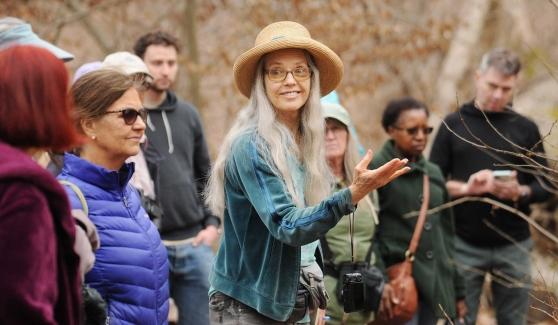Deborah Dolan has been an avid birdwatcher for years. The ecology manager at Van Cortlandt Park in the Bronx took notice. “I had a lot of entries in the park’s birding log,” Dolan said.
Volunteers including Dolan were enlisted by Dennis Burton to create an awareness of the park among its users and to plant the seeds for nurturing the park well into the future.
“He got a whole lot of nature lovers together. He was concerned that the natural habitat was taken up by other uses,” Dolan said. “We educate people about the flora and fauna of the park and, hopefully, the enhanced appreciation will result in the desire to become stewards of the park.”
Van Cortlandt Park has more than 1,000 acres and is home to the country’s first public golf course. But over the decades, the construction of highways, such as the Mosholu Parkway and the Major Deegan Expressway, has encroached on the park, disrupting its continuity.
Dolan, who lives in nearby Riverdale, was a District 65 literacy instructor before she retired in 2012. She started giving tours of Van Cortlandt Park in 2014 and has led more than 100 walks since the start of the pandemic, when the park’s usage increased just as its budget shrank.

Retired literacy instructor Deborah Dolan (center, wearing hat) describes the native trees and plants in Van Cortlandt Park, the Bronx, while leading a walk in March. Dolan, a volunteer since 2014, monitors one of four trails in the park for invasive species.
The 40 members of the Vital Volunteers of the Van Cortlandt Park Alliance monitor the invasive species that threaten native trees and plants — and yank them out because “biodiversity is threatened,” Dolan said.
Dolan is responsible for monitoring one of the park’s four marked trails. “The porcelain berry vine smothers shrubs and prevents photosynthesis,” she said of the offending growth. “Oriental bittersweet strangles trees. We’re working hard to control it so native species have more of a chance.”
Some introduced species are becoming more numerous than native species. “The Norway maple tree, introduced for shade, has advantages over the native sugar maple because it’s hardier in the cold,” said Dolan.
The volunteers give native species, such as the spice bush, room to grow and thrive. “It’s the forsythia of the woods,” Dolan said of the yellow-green bush that produces berries and attracts insects, providing migrating birds with an in-flight snack. The bush also provides cover for birds, rabbits and squirrels hiding from predators.
Formerly a docent at the Teatown Preserve’s Wildflower Island in Ossining, New York, Dolan currently is the conservation chair of the Hudson River Audubon Society.
“I’ve always been interested in birds and nature,” Dolan said. “We are rediscovering nature.”